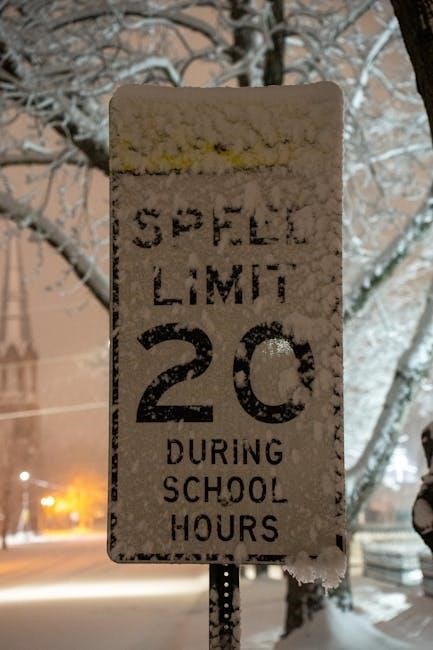NFPA 20 is a critical standard for fire protection‚ outlining installation requirements for stationary fire pumps. It ensures reliable operation in emergency situations‚ published by the National Fire Protection Association.
Scope of NFPA 20
NFPA 20 covers the installation of stationary fire pumps‚ controllers‚ and related equipment. It includes requirements for power sources‚ piping‚ and components essential for fire pump systems.
2.1. Purpose and Application
The purpose of NFPA 20 is to ensure stationary fire pumps operate reliably during emergencies. It applies to fire protection systems in various settings‚ providing detailed installation guidelines for pumps‚ controllers‚ and related components. The standard addresses performance requirements‚ design criteria‚ and testing procedures to maintain system integrity. Compliance with NFPA 20 is essential for safeguarding people and property by ensuring fire pumps function effectively when needed. Its application spans commercial‚ industrial‚ and residential fire safety systems‚ making it a critical resource for engineers‚ contractors‚ and safety professionals.
2.2. Retroactivity
NFPA 20 includes provisions for retroactivity‚ ensuring existing fire pump systems remain compliant with updated standards. Retroactivity requires that older systems meet current safety and performance criteria‚ either through upgrades or modifications. The standard specifies which requirements apply retroactively and how they should be implemented. This ensures continuous improvement in fire protection without requiring complete system overhauls. Retroactivity clauses balance the need for enhanced safety with practical considerations for maintaining existing infrastructure. Compliance with retroactive requirements is essential for ensuring fire pumps remain reliable and effective over time‚ even as new technologies and standards emerge.
Key Definitions in NFPA 20
NFPA 20 provides essential definitions to clarify terminology used in the standard. Key terms include “fire pump‚” defined as a pump specifically designed to provide water for fire protection systems. The “driver” refers to the power source‚ such as an electric motor or diesel engine‚ that powers the pump. A “controller” is the device that manages the pump’s operation‚ including starting‚ stopping‚ and monitoring. Other critical definitions include “jockey pump‚” “suction pressure‚” and “discharge pressure‚” which are vital for understanding system design and functionality. These definitions ensure consistency in application and interpretation of the standard‚ forming the foundation for proper installation and operation of fire pump systems.
Design Requirements for Fire Pumps
NFPA 20 requires fire pumps to deliver at least 80% of rated capacity at 70% of total head‚ ensuring reliable performance in fire protection systems.
4.1. Pump Capacity and Efficiency
NFPA 20 specifies that fire pumps must deliver at least 80% of their rated capacity at no less than 70% of the total rated head. This ensures reliable performance in fire protection systems. Pump capacity is determined based on the required flow rate and pressure‚ while efficiency is measured to minimize energy losses. The standard emphasizes precise calculations to match pump performance with system demands‚ ensuring optimal operation under varying conditions. Compliance with these requirements guarantees that fire pumps can maintain sufficient water supply during emergencies‚ critical for fire suppression and safety. The guidelines also address factors affecting pump efficiency‚ such as suction conditions and piping layout.
4.2. Construction Materials and Standards
NFPA 20 mandates that fire pump components‚ such as casings‚ impellers‚ and shafts‚ must be constructed from durable materials like bronze‚ stainless steel‚ or ductile iron to ensure longevity and resistance to corrosion. These materials must comply with recognized standards‚ such as ASTM specifications‚ to guarantee reliability in harsh environments. The standard also specifies that all components must be designed to withstand the stresses of continuous operation and extreme temperatures. Adherence to these material and construction requirements ensures that fire pumps remain operational during emergencies‚ maintaining the integrity of fire protection systems. Compliance with these standards is critical for ensuring pump durability and performance.

Electrical Requirements for Fire Pumps
NFPA 20 specifies requirements for fire pump controllers‚ power sources‚ and circuit design to ensure reliable operation during emergencies‚ adhering to strict safety and performance standards.
5.1. Controllers and Control Panels
Controllers and control panels for fire pumps must meet specific requirements under NFPA 20 to ensure reliable operation and monitoring. These components are critical for controlling the fire pump’s startup‚ shutdown‚ and alarm functions. The standard mandates that controllers must be listed for fire pump service and designed to handle the pump’s motor voltage and current. Control panels should provide clear indications of system status‚ including running‚ fault‚ and alarm conditions. Additionally‚ they must ensure proper power supply and circuit protection to maintain fire pump readiness. Compliance with these requirements ensures the fire pump system operates effectively during emergencies‚ safeguarding people and property. Proper installation and testing are essential.
5.2. Power Sources and Circuit Design
NFPA 20 mandates that fire pump power sources and circuit designs must ensure uninterrupted operation during emergencies. The standard requires a reliable primary power source‚ such as a dedicated electrical circuit‚ and may specify backup sources like generators. Circuit design must account for voltage drop‚ motor starting current‚ and fault protection to prevent overloads. Proper sizing of conductors and protection devices is critical to maintain system performance. Compliance with these requirements ensures that fire pumps remain operational‚ providing consistent water pressure and flow during fire incidents. Adherence to NFPA 20’s power and circuit guidelines is essential for safeguarding lives and property by ensuring fire pump reliability.

Installation Guidelines
NFPA 20 provides detailed installation guidelines for fire pumps‚ including location‚ environmental considerations‚ and piping configurations; Proper installation ensures reliability‚ safety‚ and compliance with fire protection standards. NFPA 20 emphasizes correct placement to avoid hazards and maintain accessibility‚ crucial for emergency operations.
6.1. Location and Environmental Considerations
The location of fire pumps must be carefully selected to ensure accessibility‚ protection from hazards‚ and optimal performance. NFPA 20 recommends placing pumps in areas with stable temperatures‚ avoiding extreme heat or cold. Environmental factors such as humidity‚ dust‚ and potential exposure to chemicals should be considered to prevent damage. Proper drainage and ventilation are essential to maintain reliability. Pumps should be positioned to minimize vibration and noise. NFPA 20 also emphasizes the importance of securing pumps in seismically active areas. Environmental considerations are critical to ensure the longevity and functionality of fire protection systems‚ as outlined in the standard. Compliance with these guidelines ensures safety and reliability in emergency situations.
6.2. Piping and Suction/Discharge Configuration
NFPA 20 provides detailed requirements for piping and suction/discharge configurations to ensure efficient and reliable fire pump operation. Proper pipe sizing is critical to maintain required flow rates and prevent pressure losses. The standard specifies that suction piping should be designed to minimize turbulence and avoid cavitation‚ while discharge piping must handle high-pressure flows without sacrificing performance. Configuration options‚ including parallel and series setups‚ are addressed to meet specific system needs. NFPA 20 also emphasizes the importance of installing check valves‚ pressure gauges‚ and drain valves to monitor and control the system effectively. Correct piping layout ensures optimal water supply and system reliability in emergency situations.

Testing and Acceptance Procedures
NFPA 20 specifies rigorous testing and acceptance procedures for fire pumps‚ emphasizing performance verification‚ reliability‚ and compliance with safety standards‚ as outlined in the 2019 edition.
7.1. Initial Testing Requirements
NFPA 20 mandates comprehensive initial testing for fire pumps to ensure operational readiness and reliability. Tests include verification of pump capacity‚ pressure‚ and efficiency under varying conditions. The standard specifies that pumps must deliver at least 80% of their rated capacity at 70% of total rated head. Additionally‚ the system must undergo performance evaluation‚ including flow rates and pressure measurements‚ to confirm compliance with design specifications. These tests are critical to guaranteeing that fire pumps perform effectively in emergency situations‚ protecting lives and property by maintaining consistent water supply and pressure.
7.2. Periodic Inspection and Maintenance
NFPA 20 emphasizes the importance of regular inspections and maintenance to ensure fire pump systems remain operational. Inspections should be conducted weekly‚ monthly‚ and annually‚ focusing on system components like oil levels‚ coolant‚ and battery condition for diesel engines. Hydraulic and electrical systems must be checked for leaks‚ corrosion‚ and proper function. Maintenance tasks include replacing worn parts‚ testing control panels‚ and ensuring suction/discharge valves are fully open. These periodic checks help identify and address potential issues before they lead to system failure. Compliance with these requirements is critical to guaranteeing the reliability and effectiveness of fire pumps in emergency situations‚ safeguarding people and property from fire hazards.
Compliance and Certification
NFPA 20 ensures compliance and certification for fire pumps‚ requiring manufacturers to meet strict standards for installation‚ controllers‚ and drivers to ensure reliability and safety.
8.1. Manufacturer Compliance and Certification
Manufacturers must ensure fire pumps meet NFPA 20 standards‚ including design‚ performance‚ and testing. Third-party certification verifies compliance‚ while documentation and inspections confirm adherence to safety requirements.

Historical Development of NFPA 20
NFPA 20 was first introduced in 1896 by the National Fire Protection Association (NFPA) to standardize the installation of fire pumps for fire protection systems. Over the years‚ it has evolved to address advancements in technology and industry needs. The standard has undergone numerous revisions‚ with significant updates in the 2013 and 2019 editions‚ incorporating changes in testing procedures and new technologies. Its development reflects a commitment to improving fire safety and ensuring reliable pump performance in emergencies. NFPA 20 remains a cornerstone for fire protection systems worldwide‚ continuously adapting to modern challenges and maintaining its critical role in public safety.

Where to Download NFPA 20 PDF
The NFPA 20 PDF can be downloaded from the official NFPA website or authorized distributors like Public.Resource.Org‚ ensuring access to the latest edition for fire protection compliance.
10.1. Official Sources and Authorized Distributors
The official NFPA website (nfpa.org) provides direct access to the NFPA 20 PDF. Authorized distributors like Public.Resource.Org also offer downloads‚ ensuring compliance with fire safety standards. These sources guarantee the latest editions and updates‚ crucial for adherence to current fire protection regulations. NFPA 20 documents are often incorporated into federal law‚ making official sources the most reliable option. Users can download the PDF for temporary storage‚ as permitted by NFPA’s licensing agreements. Always verify the authenticity of the source to ensure the document’s accuracy and compliance with legal requirements. Official sources remain the trusted choice for professionals seeking the NFPA 20 standard.
10.2. Free Resources and Public Access Points
Public.Resource.Org offers free access to the NFPA 20 PDF‚ providing a convenient option for downloading the standard. Additionally‚ some editions‚ such as the 1999 version‚ are available on international sites like pozhproekt.ru. Certain libraries and online repositories may also provide borrowing or streaming options. However‚ ensure the document’s authenticity and compliance with current standards. Free resources are valuable but verify their reliability to avoid outdated or altered content. NFPA 20 is often incorporated into federal law‚ making public access points essential for widespread adoption and adherence to fire safety regulations. Always prioritize verified sources to maintain compliance and safety standards. Free access ensures the standard’s reach but requires careful validation for accuracy and legality.
